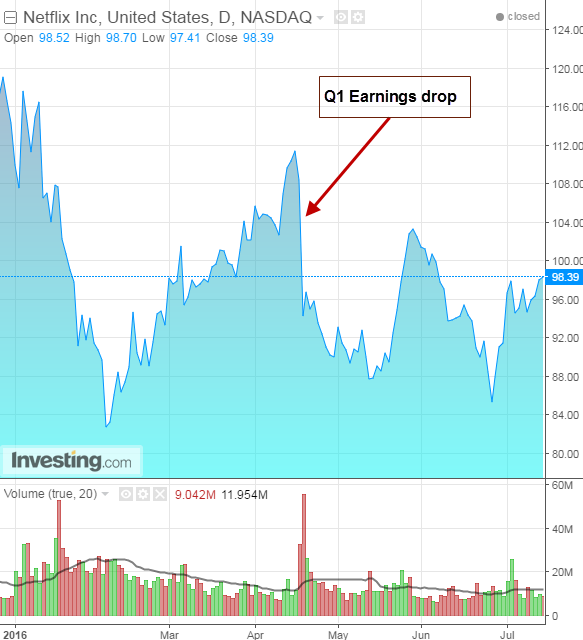by Clement Thibault
Netflix Inc (NASDAQ:NFLX) reports on Monday, July 18, after the close.

1. Revenue and earnings forecast
Netflix's forecast for Q2 2016 is $0.02 EPS on $2.11B expected. Meeting expectations would mean the company will report 25% growth in revenue year-over-year, while the EPS figure is expected to be lower than last year's $0.06 for the same period. Though the robust growth figure may seem outrageous, Netflix has been growing at a 25% YoY clip for over four quarters now. That's why it's still considered a fast growth stock along with companies such as Amazon (NASDAQ:AMZN) and LendingClub (NYSE:LC) whose stocks are also valued at hundreds of times earnings (NFLX's current P/E is 340). It's entirely possible they'll continue this trend again in Q2 2016, but expectations might need to be re-adjusted going forward to the next earnings season.
2. Revenues aren't everything
While revenue is important, Netflix's growth is driven by new subscribers. In already developed markets such as North America, Latin America and Australia, new subscribers are mainly a result of NFLX's unique and appealing content. House of Cards, the company's first original production, was released in early 2013; It became such a huge hit that additional seasons were commissioned. The final season was released this year. It has spurred millions of new subscriptions. Orange is the New Black, another mega-hit for Netflix, was released in the summer of 2013. It is now in its fourth season and has been renewed for three additional seasons.
Netflix produces a variety of other programming as well. Of course, its content competes with a broad variety of material from networks and cable stations as well as HBO's (NYSE:TWX) juggernaut, Game of Thrones. Additionally, Netflix's biggest hits are already into multiple seasons, which means it needs to look elsewhere for promising new growth. For this reason it recently entered into agreements with Disney (NYSE:DIS) for film streaming, and with the CW Network—jointly owned by CBS Corporation (NYSE:CBS) and Paramount (NYSE:PGRE)—for content that includes the popular DC comics series Flash and Arrow.
Last quarter, NFLX missed expectations on new international subscriptions, which sent shares tumbling from $108 to just $94, or a loss of 13%. This time around, Netflix said it expected to add 2 million international subscribers, which is well below Wall Street's expectation of 3.5 million subscribers. The trouble is likely being generated out of Asia (see #3, below). Are Netflix's shares doomed to repeat the plunge they experienced after the Q1 report? Will the lack of a new megahit hamper forward growth? Stay tuned.
3. Troubles in Asia
Netflix's dominant presence in North America, Latin America and Australia presents further expansion hurdles since these markets are fully developed and unlikely to be growth engines anytime soon. Asia should be Netflix's new growth driver, but stiff competition from global players such as Amazon, HBO and the UK's BBC, as well as smaller local players including South Korea's Frograms Inc and SK Telecom Corporation Ltd (NYSE:SKM), is splintering available market share. In addition, lack of localized content for many Asian countries further diminishes Netflix's appeal. To add to its troubles, some local markets, such as Indonesia, have been raising regulatory barriers including censorship and taxation issues. Most significant, Netflix—like many other content providers—is still barred from entering the heavily regulated Chinese market.
4. Price hike in May
Back in May, Netflix began rolling out a gradual price hike to all its customers, raising rates from $7.99 to $9.99. While the price hike will inevitably lead to a loss of some subscribers, it will also bolster the company's revenue by almost 25%. As the company is unlikely to lose 25% of its customer base, this should prove to be a good move by management; We should see some of the benefit in today's Q2 report.
Everyone's favorite stock in 2015 has cooled significantly during the first half of 2016. It is now down more than 15% on the year.
Looking ahead, Netflix will find it harder to sustain the growth trend Wall Street has come to expect, which will in turn lower expectations—but not before hammering the stock a few times. As mentioned above, Netflix's 340 P/E is based on expectations of extraordinary growth of both revenues and subscribers.
Unfortunately, revenue growth will be harder to achieve as the competition ramps up, and substantial subscriber growth isn't likely to happen...unless Netflix is able to breach the Great Wall of China.
